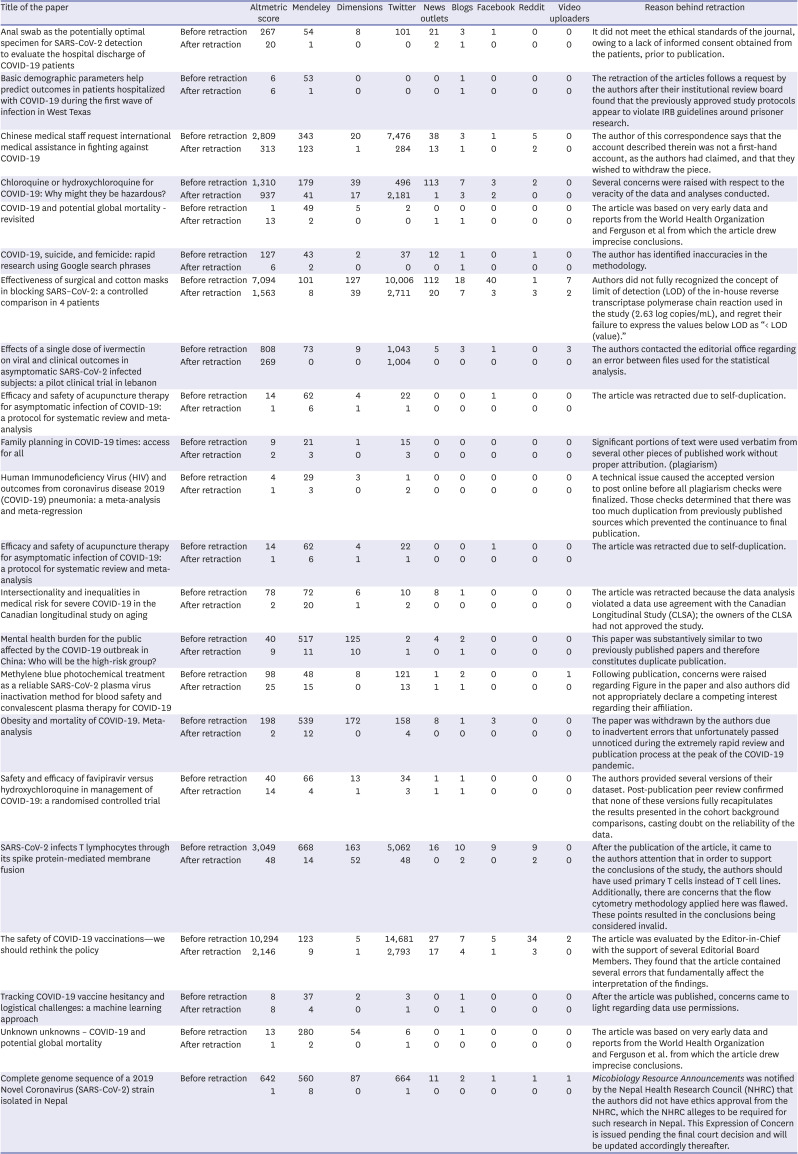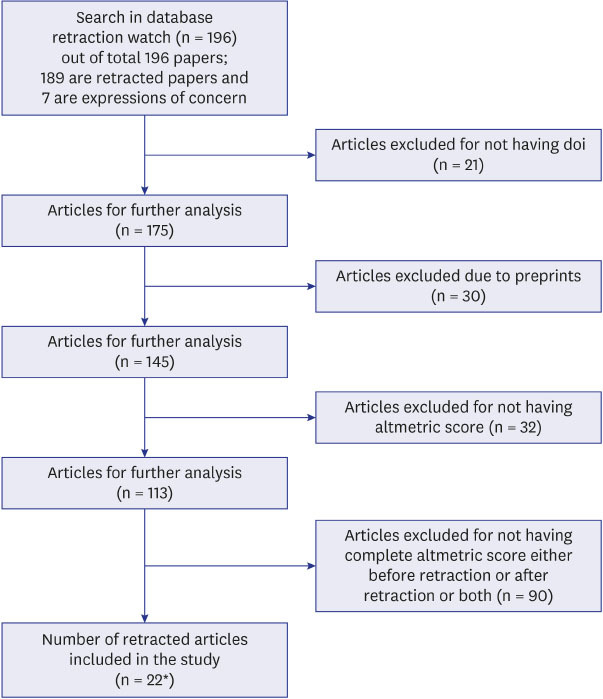1. Gasparyan AY, Zimba O, Misra DP, Kitas GD. Monitoring information flow on coronavirus disease 2019 (COVID-19). Mediterr J Rheumatol. 2020; 31(Suppl 2):243–246. PMID:
33195999.
2. Banerjee D, Meena KS. COVID-19 as an “Infodemic” in public health: critical role of the social media. Front Public Health. 2021; 9:610623. PMID:
33816415.
3. Dunn AG, Mandl KD, Coiera E. Social media interventions for precision public health: promises and risks. NPJ Digit Med. 2018; 1(1):47. PMID:
30854472.
5. Soltani P, Patini R. Retracted COVID-19 articles: a side-effect of the hot race to publication. Scientometrics. 2020; 125(1):819–822.
6. Serghiou S, Marton RM, Ioannidis JP. Media and social media attention to retracted articles according to Altmetric. PLoS One. 2021; 16(5):e0248625. PMID:
33979339.
7. Teixeira da Silva JA. Adjusting the use of preprints to accommodate the ‘quality’ factor in response to COVID-19. J Taibah Univ Med Sci. 2021; 16(4):477–481. PMID:
34408603.
9. Moylan EC, Kowalczuk MK. Why articles are retracted: a retrospective cross-sectional study of retraction notices at BioMed Central. BMJ Open. 2016; 6(11):e012047.
10. Candal-Pedreira C, Ruano-Ravina A, Fernández E, Ramos J, Campos-Varela I, Pérez-Ríos M. Does retraction after misconduct have an impact on citations? A pre-post study. BMJ Glob Health. 2020; 5(11):e003719.
12. Anderson C, Nugent K, Peterson C. Academic journal retractions and the COVID-19 pandemic. J Prim Care Community Health. 2021; 12:21501327211015592. PMID:
33949228.
15. Kambhampati SB, Vasudeva N, Vaishya R, Patralekh MK. Top 50 cited articles on Covid-19 after the first year of the pandemic: a bibliometric analysis. Diabetes Metab Syndr. 2021; 15(4):102140. PMID:
34186371.
17. David CC, San Pascual MR, Torres ME. Reliance on Facebook for news and its influence on political engagement. PLoS One. 2019; 14(3):e0212263. PMID:
30889186.
18. Keller B, Labrique A, Jain KM, Pekosz A, Levine O. Mind the gap: social media engagement by public health researchers. J Med Internet Res. 2014; 16(1):e8. PMID:
24425670.
19. Kavadichanda C. Journal metrics: different from author metrics. Indian J Rheumatol. 2020; 15(3):149–154.
20. Househ M. The use of social media in healthcare: organizational, clinical, and patient perspectives. Stud Health Technol Inform. 2013; 183:244–248. PMID:
23388291.
21. Goel A, Gupta L. Social media in the times of COVID-19. J Clin Rheumatol. 2020; 26(6):220–223. PMID:
32852927.
22. Ecker UK, Antonio LM. Can you believe it? An investigation into the impact of retraction source credibility on the continued influence effect. Mem Cognit. 2021; 49(4):631–644.
24. Tang Y, Tseng H, Vann C. Unwrap citation count, Altmetric Attention Score and Mendeley readership status of highly cited articles in the top-tier LIS journals. Mem Commun. 2020; 69(8-9):653–664.
25. Kouzy R, Abi Jaoude J, Kraitem A, El Alam MB, Karam B, Adib E, et al. Coronavirus goes viral: quantifying the COVID-19 misinformation epidemic on Twitter. Cureus. 2020; 12(3):e7255. PMID:
32292669.
26. Prieto Curiel R, González Ramírez H. Vaccination strategies against COVID-19 and the diffusion of anti-vaccination views. Sci Rep. 2021; 11(1):6626. PMID:
33758218.
27. Brüssow H. COVID-19: vaccination problems. Environ Microbiol. 2021; 23(6):2878–2890. PMID:
33928745.
28. Johnson NF, Velásquez N, Restrepo NJ, Leahy R, Gabriel N, El Oud S, et al. The online competition between pro- and anti-vaccination views. Nature. 2020; 582(7811):230–233. PMID:
32499650.
29. Lentzen MP, Huebenthal V, Kaiser R, Kreppel M, Zoeller JE, Zirk M. A retrospective analysis of social media posts pertaining to COVID-19 vaccination side effects. Vaccine. 2022; 40(1):43–51. PMID:
34857421.
30. Li HO, Bailey A, Huynh D, Chan J. YouTube as a source of information on COVID-19: a pandemic of misinformation? BMJ Glob Health. 2020; 5(5):e002604.
31. Udawatta M, Ng E, Westley Phillips H, Chen JS, Wilson B, Prashant GN, et al. Age-related differences in social media use in the neurosurgical community: a multi-institutional study. Clin Neurol Neurosurg. 2019; 180:97–100. PMID:
30953974.
32. Alsobayel H. Use of social media for professional development by health care professionals: A cross-sectional web-based survey. JMIR Med Educ. 2016; 2(2):e15. PMID:
27731855.
33. Ventola CL. Social media and health care professionals: benefits, risks, and best practices. P&T. 2014; 39(7):491–520. PMID:
25083128.
34. Ahmed S, Gupta L. Perception about social media use by rheumatology journals: survey among the attendees of IRACON 2019. Indian J Rheumatol. 2020; 15(3):171–174.
36. Gupta L, Gasparyan AY, Misra DP, Agarwal V, Zimba O, Yessirkepov M. Information and misinformation on COVID-19: a cross-sectional survey study. J Korean Med Sci. 2020; 35(27):e256. PMID:
32657090.
37. Khan H, Gasparyan AY, Gupta L. Lessons learned from publicizing and retracting an erroneous hypothesis on the mumps, measles, rubella (MMR) vaccination with unethical implications. J Korean Med Sci. 2021; 36(19):e126. PMID:
34002546.
39. Gaur PS, Gupta L. Social media for scholarly communication in Central Asia. Cent Asian J Med Hypotheses Ethics. 2020; 1(2):152–157.
40. King A. Fast news or fake news? The advantages and the pitfalls of rapid publication through pre-print servers during a pandemic. EMBO Rep. 2020; 21(6):e50817. PMID:
32496027.
41. Fraser N, Brierley L, Dey G, Polka JK, Pálfy M, Nanni F, et al. The evolving role of preprints in the dissemination of COVID-19 research and their impact on the science communication landscape. PLoS Biol. 2021; 19(4):e3000959. PMID:
33798194.
42. Haldule S, Davalbhakta S, Agarwal V, Gupta L, Agarwal V. Post-publication promotion in rheumatology: a survey focusing on social media. Rheumatol Int. 2020; 40(11):1865–1872. PMID:
32920728.
43. Zimba O, Gasparyan AY. Social media platforms: a primer for researchers. Reumatologia. 2021; 59(2):68–72. PMID:
33976459.
44. Eric Topol on Twitter: “Debunking another myth, the mRNA vaccines didn’t just suddenly appear in 2020 for covid-19. Many had been tested years previously for other viruses; status as of 4 years ago in this Table, and shown to be safe …”. Updated 2021. Accessed July 25, 2021.
https://twitter.com/erictopol/status/1418997501315543040?s=24
.
45. Ganatra K, Gasparyan AY, Gupta L. Modern health journalism and the impact of social media. J Korean Med Sci. 2021; 36(22):e162. PMID:
34100565.
46. Zimba O, Radchenko O, Strilchuk L. Social media for research, education and practice in rheumatology. Rheumatol Int. 2020; 40(2):183–190. PMID:
31863133.




